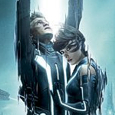Walt Disney Pictures (1982 and 2010), Walt Disney Home Entertainment (April 5 2011), 5-disc set comprising one 3D Blu-ray, two HD Blu-rays, one DVD plus Digital Copy, 96 (1982) and 125 (2010) mins plus extensive supplements, 1080p high-definition widescreen (multiple aspects), DTS-HD 5.1 (1982) and 7.1 (2010) Master Audio, Rated PG, Retail: $79.99
Storyboard:
In the 1982 classic, Kevin Flynn, a young computer programmer searching for the data that proves a rival colleague stole his ideas for a string of hit video games, is himself projected inside a computer world, where he becomes an electronic warrior who must battle to stay alive, joining forces with the security program Tron to retrieve the information he needs and find a path back to our real world…
In 2010, Flynn has gone missing, with his son Sam uneasy with the direction his father’s company, Encom, is taking under the leadership of others. When a close friend suggests that Flynn may still be alive, but once again trapped within the confines of a digital realm, Sam discovers a hidden room in his Dad’s old arcade that leads him to Flynn’s now deadly and corrupt utopia known as The Grid…
The Sweatbox Review:
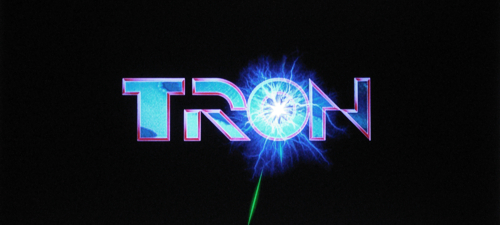
1982 was a pretty banner year for now classic sci-fi and fantasy releases, all of which were major flops on original release. If your film wasn’t called E.T. The Extra-Terrestrial, you were pretty much dead in the water. Spielberg’s film was such a phenomenon that it not only practically sunk every other title in the marketplace, but arguably gave the VHS home video format a major boost due to the sheer numbers of pirate copies that were in circulation (not, as the old joke goes, that it was much fun watching ET hobbling around with an eye-patch and a wooden leg – hoho!). Blade Runner, The Thing, Conan, Annie, Poltergeist, The Dark Crystal and countless others (including the bonkers but oddly brilliant Q: The Winged Serpent and, deservedly, the misguided Grease 2) all mostly perished in the shadow of the little alien that wanted to phone home.
As did the Disney Studios’ ambitious sci-fi drama Tron, but while the above mentioned films have all (yes, even Grease 2…to a degree) become cult classics thanks to video, and some of them rediscovered as important, overlooked pictures, Tron continues to rather undeservedly have a stick poked at it as a figure of fun. It’s an unfairly crude and too hasty a dismissal for a film that was genuinely ahead of its time, actually returned a tidy sum over double its investment in theatrical release, and inspired legions of some of today’s most recognized computer animation creators and visual effects experts. And, being a perfectly aged ten-year-old kid watching Tron in 1982, I loved it.
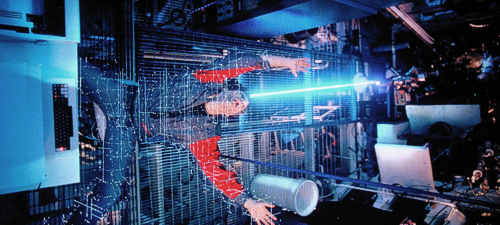
I loved Tron on the big screen and on the suspect VHS copy a friend loaned me. I loved Tron when I rented a legitimate copy of one of Disney’s first “new style” VHS releases (with the full-length poster cover art as opposed to the red/yellow “Disney Home Video” branded sleeves) which made it seem very cool. And I loved Tron’s Wendy Carlos’ score in its vinyl soundtrack release, sadly an album now lost but replaced on CD, and as one of the first VHS tapes I was able to purchase and bring home. When it came to LaserDisc, in a wonderful limited widescreen Archive Edition boxed set, I naturally grabbed a copy, as I did again for the 20th Anniversary DVD in 2002 and again now in its Blu-ray debut. A debut that has actually been delayed by Disney itself, somehow apologetically embarrassed about its own film.
Well it need not be: if it isn’t clear by now, I love Tron, and each time I’ve become reacquainted with it, I’ve always seen new things about it, as one often does when they grow up and are more aware of things around them. And so what was once an exciting high-tech film akin to something like Star Wars that could be enjoyed simply for the “ride” became something deeper, where interesting religious themes, philosophical musings over the creation of something new and remnants of the creators being left imprinted on those new creations, and the possibility of those creations going on to greater success themselves, began to emerge. Not to say that these kinds of elements swamp Tron: as I say, I didn’t even pick up on them until much later, when I found them all pretty subversive aspects to be found in what was ostensibly a kid’s action-adventure movie.
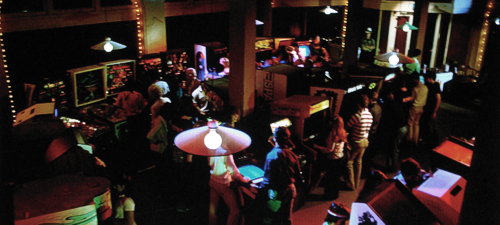
But that’s why many people dismiss Tron: because they see it only as a video game movie, even though it’s so much more than that. In fact, I’m not and have never really been into video games, which is perhaps why I loved Tron as a piece of narrative film storytelling while the video game community back then seemed to prefer the actual spin-off video games themselves (again, wouldn’t any film made today be pleased if the merchandising made twice as much as the theatrical receipts?). As far as those games went, they were pretty basic back in the old arcades, but the games in the movie itself predicted a lot of what was to come, such as first-person three-dimensional graphics.
Yep, it’s true that Tron also has a lot of what is now outdated hardware, but for a long time I knew computer geeks who still used their old systems for other uses and the high-tech research areas of Tron still look pretty cool, the huge data tapes now something strange and mysterious looking to new eyes coming to this from today’s perspective. But it has a lot of cool things too: Jeff Bridges for one thing, as the hacker Kevin Flynn who, ousted from his proper seat as the head of a large hardware/software computer company Encom, fights from the outside to prove current company chief Ed Dillinger is as slippery as they come. Actually, it’s one of Tron’s quirks that the title character is almost a sideline to the actual plot, and poor old Bruce Boxleitner never really went on to the kind of career he might have done given the more interesting Flynn character (even if he remained a sci-fi favorite in other such shows on television).

CGI – before it was even ever called that – had popped up in a couple of Disney films prior to Tron, specifically in The Black Hole, a similarly-toned film which predated Tron’s game Grid in using the same kind of graphical design for its opening title sequence. The CG in Tron was far more advanced, so much so that many of the planned sequences couldn’t actually be completed with computer processing power of the time and had to be hand augmented. The very characters themselves – planned to be beams of electronic light back when it might have been a fully animated film – were filmed in a pre-digital alternative to the green screen, and were then optically rotoscoped and given pulsating light bursts on their (admittedly) cloth costumes.
If there is one thing “wrong” with Tron, it’s nothing that would be called bad filmmaking, but it could be that it was trying to achieve things that were impossible to be done. Good filmmaking pushes technology forward as a side-effect of making the film, but in Tron’s case it was all about the technology, and some of it just wasn’t up to scratch. It’s perhaps these aspects that give those ready to criticise their ammunition, but among the film’s supporters, we can overlook those details and in many cases defend them: I, for one, have always liked the jittery nature of the rotoscoped lines and light beams, which give the characters an always alive but never quite real feeling, as if the digital particles or their pixel atoms are continuously repositioning themselves to keep the characters intact.

The rest of Tron’s casting is great too, especially Bernard Hughes and David Warner, who both find themselves cast as their counterparts “on the other side of the screen”, in a Wizard Of Oz casting decision that perhaps suggests Flynn’s journey over the light beam and into this amazing, neon-colorful new world is just a figment of his imagination or if it might have really happened. Indeed, critics picked up on this parallel alongside offering up Tron as a computer age 2001: A Space Odyssey, a tag that was exploited on some posters where the film was titled Tron: An Electronic Odyssey (another substituted The Electronic Gladiator…you get the idea). It’s an apt comparison since, just as with Kubrick’s space epic, Tron splits audiences in two and delivers the same kind of un-naturalistic tone. Unless you’re able to plug yourself into Tron’s concept, you might find it an emotionally cold picture.
But it’s also a very unique one, offering “sights and sounds like those never before seen by the human eye” as one quote had it. Chiefly among those sounds is Wendy Carlos’ excellent music score: known for her work with synthesizers (including her albums of classical music recreations and, interestingly, a couple of film projects with Kubrick), it was natural that she be picked to provide the unique sound director Steven Lisberger was listening for. Expertly weaving synths in with orchestra and choir, Carlos manages to create a unique sound for Tron that sits perfectly with the synthesized images onscreen, and it’s a score that, for my money, successfully uses those capabilities much more integrally and expressively than, say, Jerry Goldsmith’s many attempts to weave the two together.
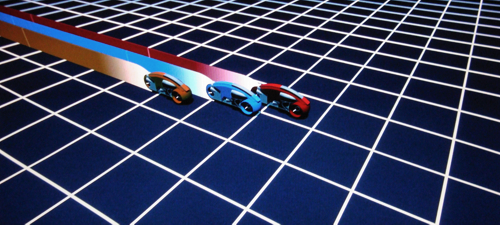
By now, I expect Tron has been seen by more people than not, even perhaps by the inquisitive that were drawn to Tron World by the film’s belated 2010 sequel, despite Disney’s best efforts to withdraw the film from view, widely seen as an attempt not to put off new audiences coming to the new film. And while I can understand that kind of thinking to a degree, it doesn’t help the Studio’s cause in trying to make the film sound like an overlooked gem unlike, say, the way Superman or Star Wars were dusted down when new recent films in those franchises came along.
That’s a real shame because Tron is a pretty good movie that, uniquely among summer blockbusters, has something to say among its electronic battles and visual effects wizardry. And it obviously had a huge impact on those responsible for the sequel, from design and character standpoints, to the integration of the music and a terrific raft of back-references that, ultimately, might have been so steeped in Tron lore as to pull off the same trick as its predecessor and become a film too accessible to a core group and not quite enough to others.
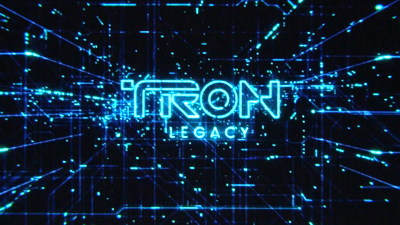
From the start, Disney promoted Tron: Legacy as being geared to be as openly entertaining to general audiences (and those coming to Tron World for the first time) as it would be to the Tron geeks who had continued to support the original film. But in many ways, the crew under director Joseph Kosinski have essentially remade the first film again, not only in tone but in the structure of its story, slaving to the original film’s premise so much that even I did wonder, when I saw the film theatrically, how on earth many people would know what was going on without having seen Tron. Well, that may be taking it a little far: there’s a lot of new setting up and filling in backstory in Tron: Legacy’s opening scenes, but to really catch all the nuances, the many geek-out moment references, quoted lines of dialogue and plot points, one really does have to have seen the 1982 film and know it fairly well.
But just as much as it has a little fun in store for all the fans that have been clambering for this film for almost 30 years, Tron: Legacy’s ultimate failing is that it then does almost little more than simply play out the same basic plot once more. Not that there’s really much wrong with that: it’s actually interesting to see how a similar narrative can be differently interpreted with so much time having passed between them, but to big fans, the euphoria of being back in the company of Kevin Flynn might be subdued by finding that, as much as things have changed, the more they have stayed the same. Yes, Bridges is back, this time not only as the Flynn of 2010, but also as the Flynn of 1982 and 1985, as well as the film’s antagonist, the rogue program Clu, picking up where the duplicitous Master Control Program left off from the original film.

The originally leaked scenario, which suggested that Clu had been designed as an internet security program and was about to go rogue when he realized the best way to protect those using the web was to destroy it (what isn’t there can’t kill you), sounded pretty neat, with Flynn again enlisting Tron’s assistance in deleting Clu before he could cause permanent damage. But in the resulting film, the emphasis is placed on Flynn’s son Sam, who enters the electronic world while searching for his estranged father and finds him held captive by Clu for reasons that are, ultimately, rather silly: he wants to create a digital army and break out of the computer world to rule our real one.
For one thing, those who haven’t seen the original film may be wondering how these characters intend to zip back and forth to each world, since the particle beam separator that was set-up back in 1982 is only shown briefly and not explained here: us Tron fans know what’s in store, but it could be a tad confusing for newbies. Also, our suspension of disbelief can be held in that same laser beam so that we buy the Flynns’ being transported to the digital realm, because we have seen, in 1982, an orange being digitized and re-produced by the system. “Here goes something, here comes nothing” makes sense, because it’s a biological form being suspended in the beam, but quite how Clu and his army could survive – let alone what would make up their chemical composition – isn’t ever addressed, despite one character emerging into our real world which is the one aspect of the film’s ending that doesn’t sit quite right no matter how well it is handled and almost slipped by us with an expert sleight of hand.

Clu is also the character that gives Legacy its most unique selling point and its most frustrating lack of fulfilling that very same ambition: a young Jeff Bridges. Legacy picks up almost immediately after the events of the first film, and CG technology being what it is, we were most excited when it was announced Bridges would be playing himself as seen in the original movie. In many ways it’s a masterstroke to cast the hero of the earlier movie as the villain of this new one, but just as Tron had its own share of technological boundaries to surmount, so does Tron: Legacy, but with Clu the challenge isn’t really met. The problem is down to the technique employed: instead of shooting Bridges on-set and then “de-aging” him as per Brad Pitt in The Curious Case Of Benjamin Button, the dreaded motion-capture has been brought into play.
In the behind the scenes material shown on television in the run-up to Legacy’s release and featured in the supplements here, it’s actually remarkable how young Bridges still looks without the beard sported by the older Kevin Flynn in the film. Quite why he couldn’t have been filmed sans facial hair, or at least had his real eyes used as a reference for the Clu character is the reason the concept behind Clu fails. If the first film’s effects were not always great because of the limits of technology, the same is true here, and instead of a living, breathing young Bridges as Clu, we’re given a typically dead-eyed and less expressive digital puppet that’s being driven by Bridges’ mo-capped performance.

And less expressive is right: all young Bridges/Clu does is look mildly menacing while attempting a malicious half-smile/grin, and after the first three or four times it just starts to get either boring, or unintentionally funny. It wouldn’t have been so bad if they had relegated this trick simply to the Clu character: I could have even bought that, since he was a digitally perfect representation of Kevin Flynn when he was created and, ultimately, a synthetic being. But the film also casts Bridges as a young Flynn, circa the same time, and it’s here that the waxy mo-cap result is less forgivable. Indeed, the opening scene is supposed to wow us by showing us a young Kevin Flynn, looking just as he did in Tron ’82, but the big money shot close-up looks exactly like what it is: a digitally created mo-cap mannequin. (And, yes, he pulls off that annoying smile.)
With such an important element of the film lacking, it all becomes clear as to why Legacy’s visual effects went overlooked at the Academy Awards, because for all its pointing towards the future, the film appears somewhat dated already, given the choice of technology that’s already been beaten by the likes of Weta Digital’s work. A real young Flynn/Clu would have been great, but as presented here, it just doesn’t work, especially in the final confrontation scene between old Flynn and Clu, where Clu’s lack of expressions are all-too painfully evident given that he’s sharing the screen with the real-life Bridges, emoting like the just-Oscar winner that he is (in another choice I found odd, young Flynn/Clu appears to have gained quite a bit of bulk given his much more rounded out face).
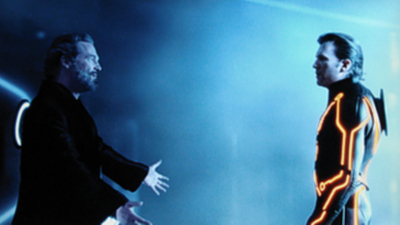
I was just as likewise left unimpressed with the much heralded music score by Daft Punk, whom I can’t say have ever really blipped on my radar. Supposedly they’re big in the techno dance and synthesizer realm, and although I wasn’t familiar with their stuff and disappointed that Carlos would not be returning, I was excited by what might be in store after hearing their music on the leaked Comic-Con teaser trailer, which seemed to promise much. Actually, I quite liked their score, it not being so far off the spirit of Carlos’, in terms of it not being traditional blockbuster music, and whenever Tron: Legacy is in a contemplative mood – which can be quite often – Daft Punk is there to support it. But their action cues were wide off the mark: whenever the movie hits such a scene, they resort to the same old synth-driven repetitious drone that passes for music in a lot of films these days, with big blasts of single chords here and there. These action sequences needed action scoring, and I was surprised that their credited collaborator Bruce Broughton wasn’t used more to bring some thematic elements to these moments. As a result they dragged and became uninvolving, contributing standard dance beats and music that isn’t really interested in what is happening on-screen.
Most disappointingly, there isn’t room for Carlos’ original themes, which I seriously ached for at least in two instances. I love it when sequels take their inspiring films’ main musical themes and build on them, often assisting the drama and characters to grow as well, but here there isn’t even a reference for what is a vastly underrated score. Young Flynn does hum a few bars of the Tron Theme to his son in the opening, but that’s as far as it goes and doesn’t really count. If there was anywhere I would have really loved a reprise to occur, it would have been when Sam returns to his Dad’s arcade, the strains of Requiem For Tron just sneaking into the score. The film has so many other reference points for true fans (Sam’s repeat of Flynn’s “Now that is a big door!” line, or Flynn’s office and hand-held video game, among so many other visual details) that having an original Carlos cue as the “Flynn’s” name came into view would have really hit home.
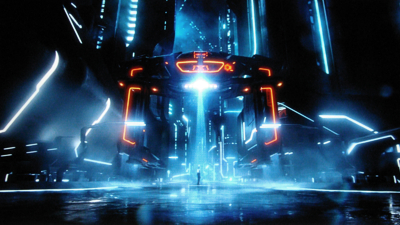
By far the worst moment in the film is a misguided club scene, where Daft Punk and their Tron-styled outfits (the duo prefer to retain their autonomy) get a cameo as DJs alongside a showboating Michael Sheen, not pulling off a Ziggy Stardust-era David Bowie impersonation before said club is raided (Sheen lapsing into his other Blair and Frost accents). The sequence – like the similarly cringe worthy moment in The Matrix Reloaded all over again, complete with the same crummy music – here is just a mess, but at least it enlivens up a pretty sparse sound design approach. What I loved about the first film was the Pac-Man type sound effects for when characters walked or ran, their feet treading the computer landscape like Pac-Man eating up his points. In Legacy there’s none of that, which means feet clunk around just as they do in the real world, and the previously super-cool sound of the Lightcycles is replaced by what doesn’t sound too far off a normal motorbike.
The lack of audio extras is mirrored in the visual design as well, the colorful, high-contrast digital neon world of Tron now a pretty depressing mix of three primary colors: pale blue, orange and black. On watching the film again I was waiting for other colors to make an appearance, but there’s very little other than just those three. The good guys are once again blue, but now an insipid pale color, while the bad guys’ red is now the toned-down orange, and neither of them pulse or suggest any kind of electrickery or life force light within them. Yes the production design has taken Tron World and made it “hyper”, getting away from the hard angles and flat greyscale surfaces for a more organic and “real” look. But that’s exactly what made Tron so interesting visually, where there was a real sense of being “inside a computer”. Here it’s more a case of being in another dimension, since there’s very little to identify being in any kind of digital location (indeed, some of the rough terrain reminded me of a negative version of Superman’s Fortress Of Solitude as seen in the Christopher Reeve movies).

But Tron: Legacy is still very largely a satisfying sequel, if not a great one. I actually loved the first half hour, with all of the wonderful hints back to the original: the recreation of the arcade and Flynn’s office, the hand held game he played in the original on his sofa in his secret lab, and repeats of fan favorite lines (you knew young Sam was going to remark on the “big door” the second it came on screen)…excellent stuff! And I found I really liked the Sam Flynn character, despite not being too excited by Garrett Hedlund in the trailers and clips. I loved seeing a returning Alan Bradley and potential hints for future films, but once Flynn was sucked in (awe, no eye-popping digitization scene?) the film dropped several notches of cool for me. It’s still good, but as if the Matrix sequels never happened, those films having come and gone between the two Tron films’ releases, and some of the dynamics have had their thunder stolen by those movies, the first in particular, which owed its own fair share of inspiration to Tron to begin with.
In many ways, it’s cool to see the Tron franchise reclaim some of those tricks as their own (except for the slo-mo jumps and leaps, which become annoying and clichéd), though the overriding feeling many may feel when watching Legacy is that it feels like a cousin more to some of Christopher Nolan’s movies, in particular The Dark Night and Inception, in terms of its color palette in the real world and the staging and music. It’s further fun to consider that while the original Tron was compared to 2001: A Space Odyssey (older Flynn’s new pad seems ripped straight out of 2001, cluttering cutlery and all, and why do programs have to eat?), Nolan himself has been likened to Kubrick, and that Legacy has that feel about it should tell you if it’s the kind of film for you or not.
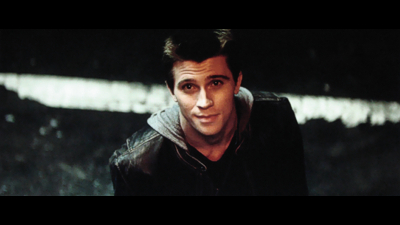
Ultimately, and arriving in theaters almost 30 years after its predecessor, Tron: Legacy isn’t the Tron sequel that original director Lisberger may have envisaged, but it picks up the pieces of the franchise and runs with it. In many ways, it is the perfect Tron sequel given the time it has taken to come to the screen. There’s no doubt that a direct 1980s follow-up would have seen Bridges and Boxleitner racing around Tron World on their Lightcycles again, but with the passing of time, the choice to feature Flynn’s son as the hero works, especially with the film finding more than enough room for Flynn himself to return, allowing for some interesting questions on the nature of fathers and sons.
The only dilemma is that, in doing so, they have conversely done little more than to remake the original film, albeit given an upgrade in many places (although again, Tron himself has been relegated to a supporting role – and not even that!). Structurally, it follows the same path as its predecessor, and often at times is so eager to remain faithful to that film that it becomes something of a slave to it. Tron: Legacy isn’t a great film, or even one that attempts the modern-day equivalent of what Lisberger and his crew set out to achieve back in 1982, but it does have its moments and, again, it does turn out to be precisely the right kind of sequel, in story terms, that any sequel to Tron being made today should be.
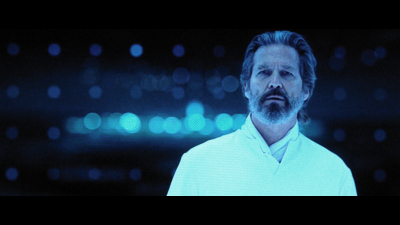
Those coming to the franchise for the first time should probably check out Tron ’82 first, to get a grip on the ideas and language of Tron World, while fans of that film may not be wowed, exactly, by Tron: Legacy, but should feel that Kevin Flynn’s own story has been given an appropriately elaborate coda. As a reboot to a franchise, it takes some brave new steps, and I hope a proposed third film does happen, though possibly with a bit more color and humor written into the code.
Is This Thing Loaded?
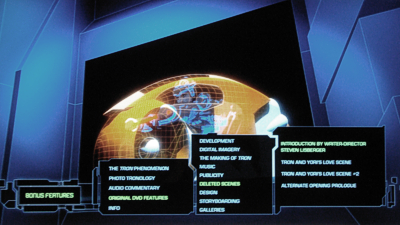
It’s the all-in, two-movie, five-disc combo pack that we’re reviewing here and, as such, there’s a healthy amount of supplements to wade through, not least over five hours awarded to the 1982 original Tron Blu-ray Disc. Much of it has been pulled over from the 2002 double-disc DVD, but it’s all great stuff well worth a revisit – and we even get a couple of new bonuses to this disc – in HD! The first of these is The Tron Phenomenon featurette (9:45), a new retrospective on the original film by those involved in the sequel, which means that, yes, Bridges, Boxleitner and Lisberger do show up appropriately. Much is made about how much Tron got right as opposed to having the film taking any more knocks, as well as exploring its unique visual approach and how the limited computing power led to having to alter original design choices, and while it doesn’t shed any specific new light, it’s a nice recap for those coming to the film for the first time.
Photo Tronology (16:40) is a very good featurette that follows original Tron director Lisberger and his son Carl as they take a trip to the Disney Archives to revisit the production of the film through variously held materials. This is certainly not a fluff piece, reflecting somewhat the bond between father and son that rises to the fore in the sequel, and works as a semi-profile of Lisberger himself as a Dad who happened to make a pretty cool movie. Again, much of the info is probably known by long-time fans, but its contemplative tone will still fascinate, as many retrospective conversations often do. Hearing new takes on old stories is always fun, and there are more than a few insightful comments about how certain aspects came to be and, true to the film’s form, the philosophical Lisberger makes a number of perceptive points on our future relationships with the computer.
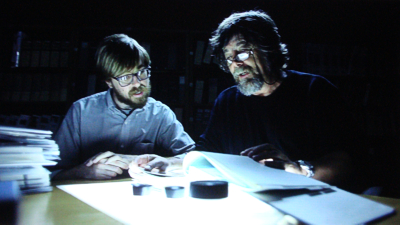
Carried over from the Exclusive Archive Edition LaserDisc and 20th Anniversary DVD is an excellent Audio Commentary with Lisberger and selected crew, and although almost 15 years old, its comments are perfectly balanced between coming a good distance after the film was made and not being outmoded today. Also pulled over are a complete archive of Original DVD Bonus Features, again much of it from the LaserDisc and so only presented in standard definition. Grouped under various topics, selecting each option usually brings up some contextual wording, making it feel like a lot of good work has gone into this disc (its main menu, for instance, manages to be perfectly Tron-authentic but absolutely up-to-date graphically, something slightly missing in the all-too drab colors of the sequel).
There are literally hours of Tron bonuses to go through here, from Development (including Early Development, Early Lisberger Studios Animation, the Computers Are People Too special excerpt, Early Video Tests and an absolutely exhaustive hi-def Gallery that features Concept, Development, Production, Publicity and Storyboard art; the Gallery is very neat with literally hundreds and hundreds of images, though many are bunched four to a screen, which could be tricky to see on smaller screens but should be okay for BD owners on larger displays). Digital Imagery explores the pre-CG companies’ work on the film, including examples of Backlight Animation, Digital Imagery In Tron, the Beyond Tron special excerpt, the Role Of Triple I and the Triple I Demo.

The Making Of Tron is a repeat of the excellent feature-length 20th Anniversary documentary on the film’s genesis and production – as in depth and all-encompassing as they come, as you would expect from the Kurtti/Pellerin team – and it’s nice to see it intact without the removal of some colorful early Tron 2.0 concept art that ultimately didn’t wind up in the eventual Legacy release. Music presents two Wendy Carlos cues unused in the completed film (the Lightcycle music understandably cut for more drama, while the end credit score is among my favorite compositions for the movie) and Publicity offers up early Work In Progress teasers and four theatrical trailers, while Lisberger himself intros three Deleted Scenes: Tron And Yori’s Love Scene Parts 1 and 2 and an Alternate Opening Prologue, dialogue-free again here although there is a further alternate edition with the prologue narrated, which is pretty darn cool.
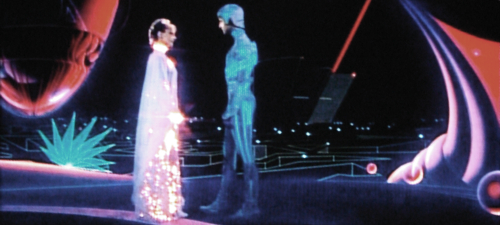
Also cool is the Design section, which features another Lisberger intro and various Lightcycle and Recognizer designer interviews and animation tests. Storyboarding looks at The Storyboarding Process, Creation Of Tron’s Main Title and a Storyboard-To-Film Comparison of the Lightcycle Chase sequence. Finally the Galleries are given their own main menu link, in addition to appearing in other sections as well. Nothing of major importance seems to have been dropped from the previous disc incarnations of Tron, meaning that if you’re experiencing the film on Blu-ray via this set or by the standalone Tron: Classic BD release, fans are sure to be pleased by the outstanding new transfer and the sheer amount of vintage material. If this were a single special edition, we’d be nearing a top score already…and there’s still more to come in this set…!
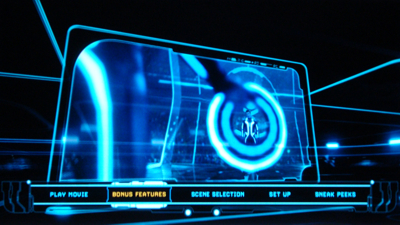
Tron: Legacy’s 3D disc doesn’t contain anything of note other than maximum space awarded to the feature itself, but the Tron: Legacy Blu-ray Disc features a nice selection of supplements, even if they’re nothing on the scale of those awarded to the first film. The lack of audio commentary is to be expected on Disney’s current releases, but that still doesn’t mean it’s both a huge disappointed and a case of potential dirty tricks from a Studio that could be looking to double-dip down the line. Given the anticipation surrounding Tron’s return to the screen, Kosinski and crew’s comments would have been most welcome, specifically to listen to his take on Tron World and how he came to his vision for it. Ho-hum…
As it is, the supplements begin with the enigmatic Tron: The Next Day featurette (10:25), rumored to be a bridging sequence between the end of Legacy and the events of a potential third film. However, I’m not sure how the events of this clip would fit into that kind of narrative when it often appears to insert itself between the first and second movies. Nevertheless, it’s an intriguing extra, made up from what seems to be material shot for Legacy in addition to some Comic-Con footage of the “Flynn Lives” event that replicated Flynn’s Arcade for an evening and some new scenes featuring Bruce Boxleitner and another old friend from the Tron franchise (whom will remain a cool secret here, ready for you to discover).
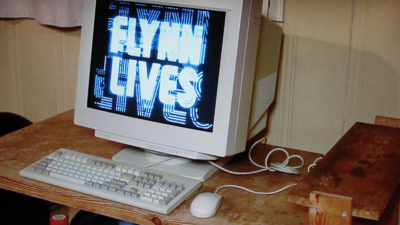
Some of these new “interviews” don’t come over quite as authentically as they could, but it’s largely an exciting piece, because it does lay some additional groundwork that either works as further background to Legacy or does indeed point to Tron’s future and a possible return for Dillinger Systems’ MCP (for instance, Cillian Murphy isn’t featured as hotshot computer whiz Dillinger Jr in an early Legacy Encom scene for nothing, y’know). Color me intrigued… After the Next Day featurette, there’s a series of Additional Clips, which appear as a highscores listing: key in the nine three-character names to release ten and a half minutes worth of material, a mixture of some of the Next Day material and some other surprises (more pointing towards the return of Dillinger and the MCP in a future sequel). Key in “ALL” to play them in succession, another fun clip being the mock-80s style commercial for Space Paranoids game.

Previously featured on Bambi’s recent BD debut, Disney’s Second Screen attempts, through the power of the internet, to sync up your BD player to virtually held content. It’s not a patch on having a picture-in-picture video commentary, but at least this one comes a little closer than Bambi’s many activities that wouldn’t have held the attention of most collectors. However, despite the wealth of additional material – from director notes, stills, storyboards, video clips and more – it can feel like an awful rigmarole to go through and keep resetting throughout watching the movie again. I took only a dip into this feature’s content and would probably return to soak up more in future – that is, until Disney loses interest and deletes the material offline, rendering Second Screen worthless. A short What Is Disney Second Screen? demonstrates the feature and how the featured content should play in sync with the movie on a separate iPad or computer screen.

Proving that Tron is now a fully-fledged Disney franchise is the fact that it will receive its own animated series this summer on the boy-centric Disney-XD channel. A First Look At Tron: Uprising isn’t anything more than a 1:15 promo for the upcoming show, which suggests this will be the Clone Wars of the Tron universe, filling in the events between the first and second movies and exploring Clu’s coup and Tron’s defecting to the dark side. Sporting a unique look that takes its cue from the new film but also harks back to the old one in having traditionally shaded characters in a CG world, Tron: Uprising looks like it could be pretty substantial fun, with a notable voice cast that is set to include Elijah Wood, Mandy Moore, Lance Henriksen, Paul Reubens and Boxleitner again returning as Tron.
Moving into the documentary featurettes proper, Launching The Legacy (10:20) documents the beginnings of Kosinski’s Tron sequel, and as much as anything I’m happy that the 2009 footage that was shown at the Comic-Con geek fest has been included here, back when the movie was potentially known as Tr2n (terrible) and the production design was a bit more colorful. The importance of Bridges’ involvement in this three minute “trailer for a movie that didn’t exist” is interesting, and one gets the feeling that the Studio might have never got around to anything Tron again had it not been for the fan reaction to the footage, which is remarkably close to scenes that were reworked for the final movie. There’s more on the visual approach in Visualizing Tron (11:46), including being the first film to build on the 3D technology of Avatar and how the first film informed the design of Legacy as well as where they differ, the rather one-tone blue color scheme all the more obvious when given comparison to the neon glow of ’82.
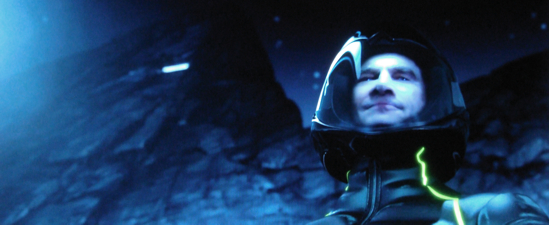
Installing The Cast (12:04) continues the actually rather good mini-documentaries, which cover decent ground. Here, the new and returning cast members discuss their roles and excitement at being involved in a new Tron, and especially palpable are the enthusiastic Bridges, still amazed and intrigued at the progression of movie technology, and Sheen, who almost redeems his clunking Bowie-style performance by admitting to being a huge Tron fanatic. Extremely interesting are the peeks at the mo-cap Bridges and how he would act out his performance as Clu in preparation of being replaced by a body double and CG head; interesting because I still can’t figure out why they went that route when Bridges, as seen without his beard, still looks young enough and lean enough to pull of the Clu role himself, which would have been much more convincing for the character and, ultimately, the success of the rest of the film.
Two shorter pieces round out the Tron: Legacy supplements, the first being a return to San Diego’s Comic-Con for Disc Roars (3:00), where director Kosinski rallied up the crowds of geeks at the Con so as to use their cries of “Disc Wars” and “De-Rez” in the massive game grid scene in the film. The video clip that prompted the audience to shout along originally contained some additional directions, one or two of which amusingly played with their ability to keep up, but this is more a look at the idea of capturing a huge audience crowd rather than simply trying to recreate it. Finally, as close to anything promotional that we are offered is the Daft Punk Derezzed Music Video (2:58), which takes the awful nightclub track but turns it around by not accompanying the low-point of the movie.
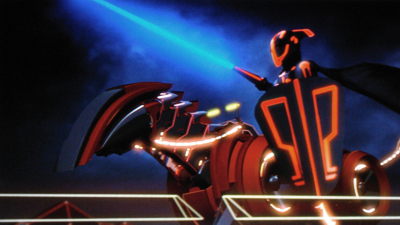
Instead, the synthesized cue is given room to breathe without being buried in a heap of digital bullet noise and, even better, the music duo turn up in a Tron World much more reminiscent of the first film. Now this melding of ’82 and 2010 visual styles is how it should be done and, despite the rather cheesy video effects, one has to agree that just this little dash of extra color and slightly more “digital” design makes all the difference in transporting us to inside the computer realm. On the DVD, the Tron: Uprising promo and Visualizing Tron and Installing The Cast featurettes are repeated, while Sneak Peeks across all discs include Pirates Of The Caribbean: On Stranger Tides, Prom, Tron: Legacy (yeah, I know, but it’s on the Tron: Classic disc also selling as a standalone), Tron: Uprising (again) and the Tron: Evolution video game, The Incredibles, Cars 2, and Disneynature’s quite wonderful-looking African Cats.
Case Study:
Also available as a standalone disc, Tron: Classic may be the one to go for if you just want to have a perfect looking version of that movie in high-definition (as well as a bundled in DVD). The only caveat there is that the packaging looks like it’s been put together by a bad movie pirate, using an obscure clip-art shot of Boxleitner as Tron badly sized and placed on the front cover, a real shame given Tron’s unique visuals and many excellent posters over the years. But help is at hand because, pleasingly, that very same disc is also a part of the 2-Movie, 5-Disc Tron: Legacy 3D configuration, which includes the new movie in “flat” and three-dimensions, alongside Tron ’82, and DVD and Digital Copies of Legacy, all fitted into a thick Blu-ray keepcase and enclosed in a snazzy slipcover that replicates the sleeve underneath with the addition of a lenticular front that does a good job of making Legacy stars Garrett Hedlund and Olivia Wilde pop out into our world. Inside, there are plugs for 3DTVs, the Movie Rewards code and a simple but cool insert promoting Tron: Uprising. Best of all is a collectible lithograph depicting Boxleitner as Tron in a publicity shot “with back light compositing”: a very welcome added touch that balances out the emphasis on Legacy in the packaging nicely!
Ink And Paint:
Tron: Classic Blu-ray:
Wow, wow, wow, wow, wow! As long as I have been watching Tron, I have never picked up on some of the visual detail that’s inherent in this frankly stunning transfer. From the opening title, I never realized that the composition of Tron by the laser beams were actually creating a turning three-dimensional character: he had always looked like a still image on previous renderings, but here it’s much more clear that Tron is slowly turning towards camera as he is being made up. A little later, you can really pick out the (intended) lines of resolution on the Lightcycle video screen in Flynn’s arcade, as well as a tear forming in Clu’s eye before he’s about to be mercilessly de-rezzed by the MCP, a great touch that suggests the digital characters’ souls right up front. When Boxleitner sits down for a chat with Dillinger, his name tag clearly shows his name as “Alan T. Bradley” – just what could that T stand for!?

Quite wonderfully, however, this new clarity doesn’t undo all of Tron’s optical effects work: yes the mattes are still there, but surprisingly not as intrusive as you may remember them. And those rotoscope glitches more than ever seem like intentional little electronic blips, and what’s very revealing is just how elaborate Tron is, from the live-action production design to the many subtle filters and effects used in the digital world. Flynn’s digitization and transport to Tron World is amazing to see in such clarity, and like my recent astonishment at seeing the likes of Snow White and Pinocchio looking better than even in their fresh high-definition editions, it was fantastic to revisit Tron again as if it were a new film. Indeed, I can’t see why Disney could have ever been worried about the film appearing dated: I’ve seen far many other “classic” movies coming off much less successfully as Tron does here. Sure, the composites might not match what computers can do today, but this only brings a new appreciation for what the filmmakers achieved and the eye-popping details that they did pull off back then. In it’s original 70mm 2.20:1 aspect ratio, it’s simply awesome.
Tron: Legacy 3D:
Just as the cover’s lenticular artwork diminishes the clarity of the background in the image, so does the 3D aspect when viewing Tron: Legacy in 3D. It’s interesting that Flynn’s amazing trip into another world in the first film was likened to Dorothy’s flying over the rainbow in The Wizard Of Oz by some critics, since Tron: Legacy takes another similarity further. Just as The Wizard Of Oz switched from the monochrome of Kansas to the Technicolor of Oz itself, Legacy uniquely uses its 3D aspects to give extra depth to the digital landscapes. So the first 25 minutes or so of the movie are “flat” after the opening dimensional Disney logo and one or two subtle shots, and it’s when Sam is projected into Tron World that Legacy beams itself into 3D. But…the film’s color tone is overall moody, which in a visual shorthand means it’s dark. Very, very dark. In fact it was so dark when I saw the film theatrically that it was the first 3D experience to give me a headache. I’m not a fan of 3D in general, but it’s not enough to put me off seeing a film I’m really looking forward to, and with the recent Tangled I must say I was very impressed.
Fortunately, I don’t seem to be prone to the kinds of eye strain that others have complained about, but filtering out extra brightness when a film is already set, for the most part, in a solemnly designed environment, won’t help the cause. And Legacy is dark. At home, of course, one can adjust your own display settings and on a 3D set-up we tried playing with the brightness and contrast levels, but the extremes were either more black and intense character costume lights, or an even more murky greyscale balance, which didn’t look very appealing and actually took a bit of the dimensional aspect away (not that it’s eye-popping to begin with: Legacy’s 3D is very much used more to suggest expansive landscapes rather than having fun with character placement, and this is one film that feels that it’s more a gimmick than a creative use). I guess the rule is that 3D works when it’s all bright colors and detailed backgrounds: moodiness doesn’t have the same effect. I liked the concept of a 3D electronic world, but not the execution.
Tron: Legacy BD:
Ahh, now this is more like it! Without the hindrance of the 3D glasses’ dimming effect, Tron: Legacy’s world doesn’t exactly brighten up, but it’s visually clearer and sharper to look at. And it’s a pretty nice image to boot, with a lot of inherent depth to it before any 3D is added. Naturally the digitally produced film looks amazing, especially in HD, so there’s nothing negative to report there, but I wasn’t so sure I was a fan of the alternating aspect ratios. Tron: Classic was shot to the 70mm ratio of 2.20:1 (as reproduced on its disc), a format now no longer widely used. Legacy was shown theatrically at the comparative 2.35:1 aspect, but in large format Imax theaters, specific scenes were shot and created for that format’s taller ratios (approximately 1.40:1).

In order to preserve the “bigger size” impact of those scenes, Legacy on disc switches between the standard 2.35 ratio and, expanding upwards and downwards as much as possible without actually altering the screen shape, the full 16:9 height of 1.78:1. In principle, it’s not something I’m too bothered about, and indeed something I was often unaware of in the 3D presentation, but unlike The Dark Knight, where this was limited to only a couple of instances, Tron: Legacy keeps switching throughout the entire picture as if it can’t make ups its mind. And that’s annoying! Even more so when it’s clear the taller ratio simply removes the widescreen mattes on the 2.35 image (as one dissolve later reveals). So although we’re getting “more” image on certain scenes – mostly, but not limited to, the big visual moments – it’s actually just more headroom rather than a huge increase in quality.
On a typical 16:9 display or projection screen, the result is an image (in the 1.78 moments) that may be “bigger” but isn’t as epic as the wider framing of the rest of the film, while those that have Constant Image Height set-ups will either have to watch the movie with half of it letterboxed or, more appropriately, simply frame it to match the wider screen and let the redundant extra image info slip off where it belongs. Really, one or the other should have been chosen, as the amount of times a switch occurs eventually just reduces the impact anyway. The DVD (which features Legacy only, the original Tron isn’t included on that format here) follows suit with the aspect ratio shenanigans, though the subdued movie design doesn’t seem to give the disc’s compression anything to worry about, and those using the bundled-in Digital Copy should also find it is more than adequate.
Scratch Tracks:
Tron: Classic’s DTS-HD 5.1 MA is simply the best the film has ever sounded, thanks to a new mix that matches the stunning new image restoration. Although I found the center speaker dialogue might be a little low in the mix, that’s something that can be quickly rectified by manually boosting that level a tad, and the rest of the soundtrack sounds like it’s been given an upgrade itself. The Lightcycles, especially, now sound like they have some pretty powerful digital engines motoring them along, while Carlos’ music sounds even better than the 20th Anniversary remastering she produced for a special edition CD release. In all, fans of Tron should find themselves in Tron World heaven, and owning the film on Blu-ray (either in this pack or as the standalone edition) is a must.
Tron: Legacy may boast a more modern 7.1 track (in the same DTS-HD MA format), but it’s less inspired sound design means it’s not quite as fun as Tron ’82. But everything is as proficient as one would expect for a 2010 blockbuster, even if it is a bit too perfunctory and not as inventive as it could have been. Alongside the more organic vistas, the audio is equally more “real world”, or “generic blockbuster”, from the motorbike-sounding Lightcycles to various spot effects and, most perceptively the Daft Punk score which, synths aside, often doesn’t connect with the screen action and reverts to the continuous repetitive notes that seems to have become a modern movie score cliché nowadays. It’s all well done, but not terribly exciting, pretty much like the movie.
For both films, French and Spanish dubs and subs are also optional, in Dolby Digital 5.1, the same tracks also available on the DVD.
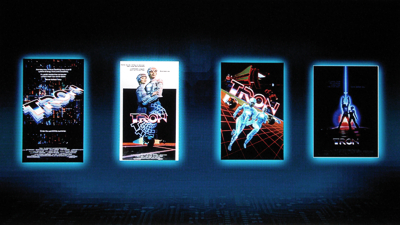
Final Cut:
An intelligent, exciting fantasy trip into another world, the original Tron has been much maligned over the years when in reality it’s the kind of film we need more of: a blockbuster with a brain. And this new hi-def edition really does invite a reappraisal and, with its excellent image and sound, make an argument for it to be rediscovered. It’s an often contemplative movie, which probably didn’t sit too well with audiences in 1982, though one hopes we may have “grown up” to appreciate its intentions more today. Disney, unfortunately, doesn’t seem to think so, given their apologetic dumping of Tron into the market almost as an extra to the new film, which picks up the Kevin Flynn story and successfully provides a fitting conclusion even if it doesn’t break the kinds of boundaries that its predecessor did.
As such, and despite often feeling like a kid again, watching Tron: Legacy isn’t as cool as seeing Tron was back in 1982, because that film did give us a completely alternate world than what we had seen before. Legacy’s game grid is much like any other CG arena, and though the multi-level Lightcycles are a more fluid upgrade, there just isn’t any visual variety to break the color tone monotony. But I really liked Sam, and I really liked how Legacy is – whatever the marketing wanted us to believe – a real and proper continuation of the first film. If anything I’d have really liked to have seen a Sam/Clu scene, where they bonded/realized that old Flynn was basically the creator/father of them both. Some good “sibling rivalry” material could have been mined there, perhaps with Clu using the situation as a pretence for a later betrayal. However, it was fun to geek out at seeing again Tron himself as well, even if that whole subplot eventually seems thrown away, I thought, for a movie that had “Tron” in the title.
The Studio’s 2-Movie, 5-Disc combo pack is a good way to catch both films, though ultimately the 3D just didn’t really do anything for me on Legacy, unique though the concept may have been. I look forward to where Tron can go next, but hope that some of the color and fun of the 1982 classic can be brought back to the franchise. In all, fans should be pleased with both films’ debut on Blu-ray, even if true to form Disney’s supplements on the second film are a little lightweight as usual. But supporters from within have at least defeated the MCP and made sure the first film gets the full treatment in style, which is surely what we have all secretly been most interested in. Let’s see where Tron goes next and, most importantly, hope that he’s given a bit more to do in his own franchise next time! End of line.
 | ||
 |



